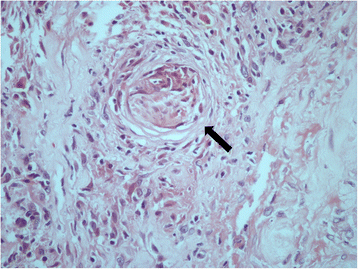Severe type 1 upgrading leprosy reaction in a renal transplant recipient: a paradoxical manifestation associated with deficiency of antigen-specific regulatory T-cells?
- PMID: 28438129
- PMCID: PMC5404339
- DOI: 10.1186/s12879-017-2406-9
Severe type 1 upgrading leprosy reaction in a renal transplant recipient: a paradoxical manifestation associated with deficiency of antigen-specific regulatory T-cells?
Abstract
Background: Due to its chronic subclinical course and large spectrum of manifestations, leprosy often represents a diagnostic challenge. Even with proper anti-mycobacteria treatment, leprosy follow up remains challenging: almost half of leprosy patients may develop reaction episodes. Leprosy is an infrequent complication of solid organ transplant recipients. This case report illustrates the challenges in diagnosing and managing leprosy and its reactional states in a transplant recipient.
Case presentation: A 53-year-old man presented 34 months after a successful renal transplantation a borderline-tuberculoid leprosy with signs of mild type 1 upgrading reaction (T1R). Cutaneous manifestations were atypical, and diagnosis was only made when granulomatous neuritis was found in a cutaneous biopsy. He was successfully treated with the WHO recommended multidrug therapy (MDT: rifampicin, dapsone and clofazimine). However he developed a severe T1R immediately after completion of the MDT but no signs of allograft rejection. T1R results from flare-ups of the host T-helper-1 cell-mediated immune response against Mycobacterium leprae antigens in patients with immunologically unstable, borderline forms of leprosy and has been considered an inflammatory syndrome in many aspects similar to the immune reconstitution inflammatory syndromes (IRS). The T1R was successfully treated by increasing the prednisone dose without modifying the other immunosuppressive drugs used for preventing allograft rejection. Immunological study revealed that the patient had a profound depletion of both in situ and circulating regulatory T-cells and lack of expansion of the Tregs upon M. leprae stimulation compared to T1R leprosy patients without iatrogenic immunosuppression.
Conclusions: Our case report highlights that leprosy, especially in the transplant setting, requires a high degree of clinical suspicion and the contribution of histopathology. It also suggests that the development of upgrading inflammatory syndromes such as T1R can occur despite the sustained immunosuppressors regimen for preventing graft rejection. Our hypothesis is that the well-known deleterious effects of these immunosuppressors on pathogen-induced regulatory T-cells contributed to the immunedysregulation and development T1R.
Keywords: Immune reconstitution syndrome; Immunosuppressors; Leprosy; Regulatory T cell; Renal transplantation; Type 1 reaction.
Figures


Similar articles
-
Leprosy in transplant recipients: report of a case after liver transplantation and review of the literature.Transpl Infect Dis. 2011 Feb;13(1):63-9. doi: 10.1111/j.1399-3062.2010.00549.x. Transpl Infect Dis. 2011. PMID: 20678090 Review.
-
A case of leprosy in central Florida.Cutis. 2017 Nov;100(5):327-329. Cutis. 2017. PMID: 29232423
-
Leprosy. An update: definition, pathogenesis, classification, diagnosis, and treatment.Actas Dermosifiliogr. 2013 Sep;104(7):554-63. doi: 10.1016/j.adengl.2012.03.028. Epub 2013 Jul 17. Actas Dermosifiliogr. 2013. PMID: 23870850 Review.
-
Mycobacterium leprae-Specific Antibodies in Multibacillary Leprosy Patients Decrease During and After Treatment With Either the Regular 12 Doses Multidrug Therapy (MDT) or the Uniform 6 Doses MDT.Front Immunol. 2018 May 14;9:915. doi: 10.3389/fimmu.2018.00915. eCollection 2018. Front Immunol. 2018. PMID: 29867930 Free PMC article.
-
Treatment of leprosy.Clin Dermatol. 2015 Jan-Feb;33(1):55-65. doi: 10.1016/j.clindermatol.2014.07.007. Clin Dermatol. 2015. PMID: 25432811 Review.
Cited by
-
Lepromatous Leprosy in an Immunosuppressed Patient Due to Renal Transplantation Associated with Glucose-6-Phosphate Dehydrogenase Deficiency: A Diagnostic and Therapeutic Challenge.Indian Dermatol Online J. 2024 May 20;15(5):873-875. doi: 10.4103/idoj.idoj_730_23. eCollection 2024 Sep-Oct. Indian Dermatol Online J. 2024. PMID: 39359304 Free PMC article. No abstract available.
References
-
- Trindade MA, Palermo ML, Pagliari C, Valente N, Naafs B, Massarollo PC, D'Albuquerque LA, Benard G. Leprosy in transplant recipients: report of a case after liver transplantation and review of the literature. Transpl Infect Dis. 2011;13(1):63–69. doi: 10.1111/j.1399-3062.2010.00549.x. - DOI - PubMed
-
- Kute VB, Vanikar AV, Shah PR, Gumber MR, Patel HV, Engineer DP, Modi PR, Shah VR, Trivedi HL. Increasing access to kidney transplantation in countries with limited resources: the Indian experience with kidney paired donation. Nephrology (Carlton) 2014;19(10):599–604. doi: 10.1111/nep.12307. - DOI - PubMed
-
- Brasil: Dimensionamento dos Transplantes no Brasil e em cada estado (2008–2015). In: Registro Brasileiro de Transplantes. vol. Ano XXI n°4, Jan/Dez 2015 edn. São Paulo: ABTO - Associação Brasileira de Transplante de Órgãos; 2015: 8.
Publication types
MeSH terms
Substances
LinkOut - more resources
Full Text Sources
Other Literature Sources
Medical

